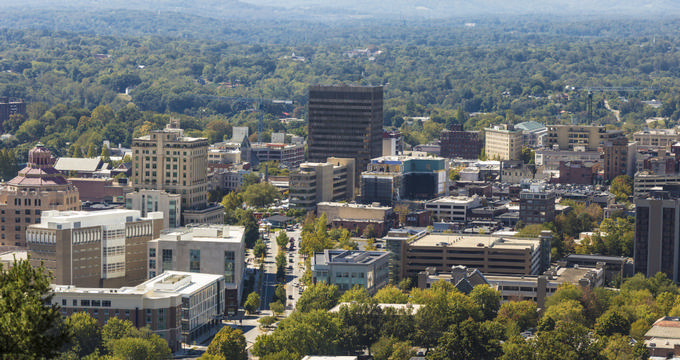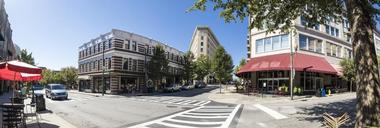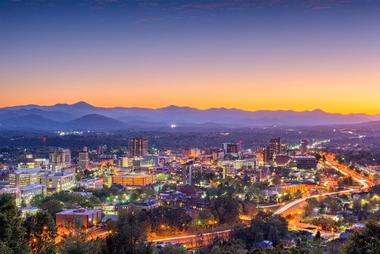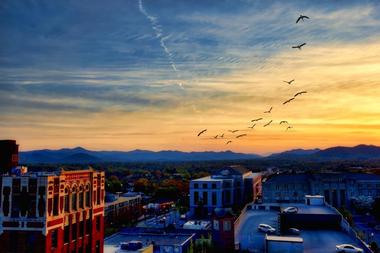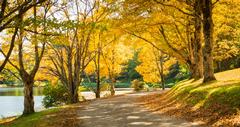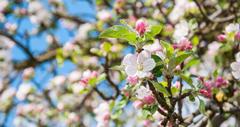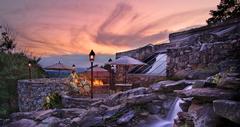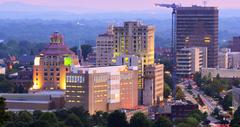The biggest city in the western side of Northern California, Asheville is the 12th most populous city in the state overall and is the county seat of Buncombe County. Notable for its live music culture and historic architecture, Asheville is a key tourist destination in North Carolina. The city covers an area of 45.3 square miles in total, with a population of approximately 90,000 people. Over 400,000 people live in the surrounding Asheville metropolitan area.
- Asheville, NC (Asheville, NC Elevation)
- Elevation of Asheville, NC
- Climate in Asheville, NC (Asheville, NC Elevation)
Attraction Spotlight: Botanical Gardens
The Botanical Gardens in Asheville in North Carolina, is a 10-acre botanical garden representing the native plants found in the Southern Appalachians. The gardens are free and open to the public, open every day of the year during day light hours.
History
The Botanical Gardens at Asheville can be found adjacent to the University of North Carolina at Asheville on a 10 acres tract that has evolved over the last 5 decades to represent the natural habitat and ecology of the Southern Appalachians. Although located on property owned by the University, the gardens are independently funded and maintained.
The idea for the Botanical Gardens was set in motion in 1959 when Ann Serota, the biology professor at the Asheville college asked the President of the college to set aside land for using as a garden and greenhouse. By 1960 more than 61 community leaders and citizens established the Asheville-Biltmore College Botanical Association with Doan R. Ogden, landscape architect, developing the garden designs.
Stage 1 of the garden was completed in the fall of 1962 with the central wildflower trail and by the Spring of 1964, more than 5,000 additional plants were added to the gardens and the Green Bridge was added. The following year, Leona Hayes donated a log cabin that was rebuilt on site and a Spring house was added in 1967. A rock garden was added in the 1970’s followed by the expansion of educational programming offered at the Botanical Gardens and a Visitor’s Center being constructed from 1980-1984. The Visitor’s Center is now the feature of the Botanical Gardens and showcases the Cole Botany Library, meeting rooms, Solarium, and Garden Path Gift Shop.
Since 2000 the Botanical Gardens at Asheville has placed a great level of importance on education, research and conservation. Through grants and endowments, the gardens have been able to set up scholarship foundations, research incentives for scientists in botany and horticulture, and add additional gardens, participate in ecology projects such as storm water biofiltration and supporting the swamp and bog complexes through a retention pond.
The Gardens
The Botanical Gardens at Asheville include over 600 species of plants that are native to the habitats of the Southern Appalachians. Many of the plants visitors can expect to see while visiting include wildflowers, trees—pine, magnolia and birch, shrubs, vines and a variety of grasses and sedges.
The habitats represented vary from shaded to full sun, dry to wet, allowing for the maximum representation of the various species that thrive in the climate of the Appalachians. 70 of the species represented in the gardens, including Swamp Pink, Oconee Bells, and French Broad Heartleaf, have been declared rare or endangered on a regional or federal level.
A half mile loop takes visitors through the main part of the gardens where the most prominent gardens and attractions are showcased:
· Sycamore Meadow
· Battle of Asheville Earthworks
· Peyton Rock Outcrop
· Sunshine Meadow
· Demmon Bridge
· Rhoades Bridge
· Joinder Bird Deck
· Wilson Bird Garden
· Former Garden for the Blind
· Glenn’s Creek
· Hayes Cabin
· Botany Center
There are also side trails such as the Unca Perimeter trails that will take visitors past the outer portion of the Gardens, Gazebo, Meadows and tree lines.
Visitors should not touch, pick, or otherwise collect or disturb any of the natural elements of the gardens. Children should be supervised always and visitors should stay on assigned walkways. Please see the website for additional rules and regulations.
Educational Opportunities
The Botanical Gardens at Asheville is dedicated to the education of adults through botanical and horticulture experiences through the gardens. IN addition to the various scholarships and endowments that are possible for university students and researchers, there are adult classes offered at the Botany Center.
The class schedule changes yearly and does require advance registration. Although visiting the gardens is free, pre-payment for classes is required and can be done so through the Visitor’s Center at the Botanical Gardens. A full list of classes being offered can be found on the Botanical Gardens at Asheville website. Past classes include:
· Cyanotype Workshops
· Wildflower Walks
· Introduction to Botanical Gardens
· Spring Tree Identification
· English Ivy Kills Trees
· Spring Bird Walks
· Edible Summertime Mushrooms
· Language of Science
· Pollinators
· Milkweed and Monarchs
· Designing with Native Plants
· Fall Bird Walks
· Winter Tree identification
Special Events
There are two special events hosted annually by the Botanical Gardens at Asheville. The gardens can also be rented for private events such as weddings, receptions, meeting and corporate events.
Spring Plant Sale-Hosted in May every spring, this sale allows local plant vendors an opportunity to sell trees, shrubs and flowers from the gazebo. This event supports the gardens and takes place regardless of weather and also features food and entertainment.
Fall Plant & Rummage Sale- This event hosted in September hosts vendors that sell plants, gardening tools, books, and other rummage items that have a horticulture, botany, or garden theme.
151 W.T. Weaver Blvd. Asheville, North Carolina, 28804, Phone: 828-252-5190
You are reading "Asheville, NC Elevation " Back to Top
Attraction Spotlight: Biltmore House and Gardens
Biltmore Estate is a beautiful Chateauesque-styled private estate and popular tourist attraction in Asheville. Owned by the Vanderbilt family, the mansion and its spectacular gardens were built between 1889 and 1895 by George Washington Vanderbilt and is currently the largest privately owned house in the United States. The regal estate, which is one of the most prominent remaining examples of the Gilded Age, can be explored on a variety of self-guided or guided tours, including a breathtaking rooftop tour, which offers unbelievable views, and a stroll through the magnificently manicured gardens.
History
After making regular visits to his mother in Asheville, George Washington Vanderbilt II decided to build own summer estate in the area. Completed in 1895, at the height of the Gilded Age, George Washington Vanderbilt II named his estate Biltmore (‘Bildt’ from the Vanderbilt's ancestors' place of origin in Holland and ‘more’ meaning open rolling land). Vanderbilt opened his spectacular estate on Christmas Eve 1895 to family and friends who were encouraged to pursue leisure and country pursuits. After changing hands through several generations, the Biltmore Estate was designated as a National Historic Landmark in 1963 and became a managed company in 1995. The Estate and its various components, such as the Biltmore Estate Wine Company, the Inn on Biltmore Estate, the Antler Hill Village, and the Village Hotel on Biltmore Estate opened to the public and remains one of the most popular tourist attractions in the country.
The Biltmore House
The luxurious family home of George and Edith Vanderbilt is truly a wonder of architecture and hospitality, spanning three floors filled with vintage clothing, elegant furnishings accessories, and original works of art by Pierre-Auguste Renoir and John Singer Sargent. Walls are adorned with magnificent 16th-century tapestries; a grand banquet hall boasts a 70-foot ceiling and peaceful library houses over 10,000 volumes. The estate also features an indoor swimming pool, a bowling alley, and no less than 65 fireplaces around the mansion.
The Gardens and Grounds
Designed by America’s foremost landscape architect Frederick Law Olmsted (of Central Park fame), the formal and informal gardens of the Biltmore Estate echo the grand elegance of the mansion with a variety of different landscapes, ranging from stylish Italian Gardens to the lush Biltmore Forest. A living tribute to Olmsted’s genius, the gardens feature a traditional Rose Garden with more than 250 varieties of roses, a century-old model for forest conservation, open meadows of Deer Park, and a rustic three-mile walking trail along the French Broad River. Olmsted incorporated two Victorian water features in the gardens – the tranquil Lagoon and Bass Pond created from an old creek-fed millpond – each of which was used for recreational activities such as fishing and rowing.
Antler Hill Village
Designed to replicate the working estates of Europe, Biltmore Estate is home to Antler Hill Village, which boasts architecturally compatible buildings, including a church, a post office, shops and a school and picturesque landscaping. Established as a point of access to the train station and the estate, the Village has grown into an entity of its own with various farming and scientific forestry programs used on the estate grounds. The Barn in Antler Hill Village offers guests the opportunity to step into the everyday lives of families who lived on the property tending crops, raising livestock, and working at Biltmore Dairy in the 1890s. Here, visitors can watch craft demonstrations, blacksmiths and woodworkers at work, and purchase unique American-made arts and crafts items, hearty snacks and more. The Farmyard presents children with turn-of-the-century games and the chance to interact with farm-friendly animals.
Outdoor Adventure Center
The Outdoor Adventure Center in Antler Hill Village offers an array of outdoor activities for all ages from biking and kayaking to trail rides and Land Rover expeditions.
Biltmore Winery
Nestled in the Blue Ridge Mountains of Asheville in the heart of Antler Hill Village, Biltmore’s 8,000-acre estate is also home to a historic winery. Visitors can enjoy specialty tastings of more than 20 handcrafted wines, as well as reserve and sparkling wines by the glass from the wine bar accompanied by delicious cheeses and locally-made truffles. Specialty tours and tastings include Red Wine & Chocolate Pairing, Wine & Cheese Hours, and exclusive Vine to Wine Tours.
Visitor Information
Biltmore Estate is open 365 days a year and hours vary according to the season. Guided tours of the house and the gardens are available by reservation.
One Lodge Street – Asheville, NC 28803, Phone: 800-411-3812
You are reading "Asheville, NC Elevation " Back to Top


